Literature Review: Vital Signs Monitoring and Clinical Deterioration
VerifiedAdded on 2023/06/14
|27
|6432
|50
Literature Review
AI Summary
This literature review examines the role of vital signs monitoring, Modified Early Warning Score (MEWS), and Rapid Response Teams (RRT) in the early identification and management of clinical deterioration in hospitalized patients. It analyzes previous studies focusing on the importance of vital signs, nurses' knowledge and practice, and the effectiveness of RRTs and MEWS in reducing adverse events, unplanned ICU admissions, and mortality. The review highlights the need for improved monitoring protocols, continuous professional development for nurses, and addressing barriers to RRT activation to enhance patient safety and outcomes. Desklib offers a wealth of solved assignments and study resources for students exploring similar healthcare topics.
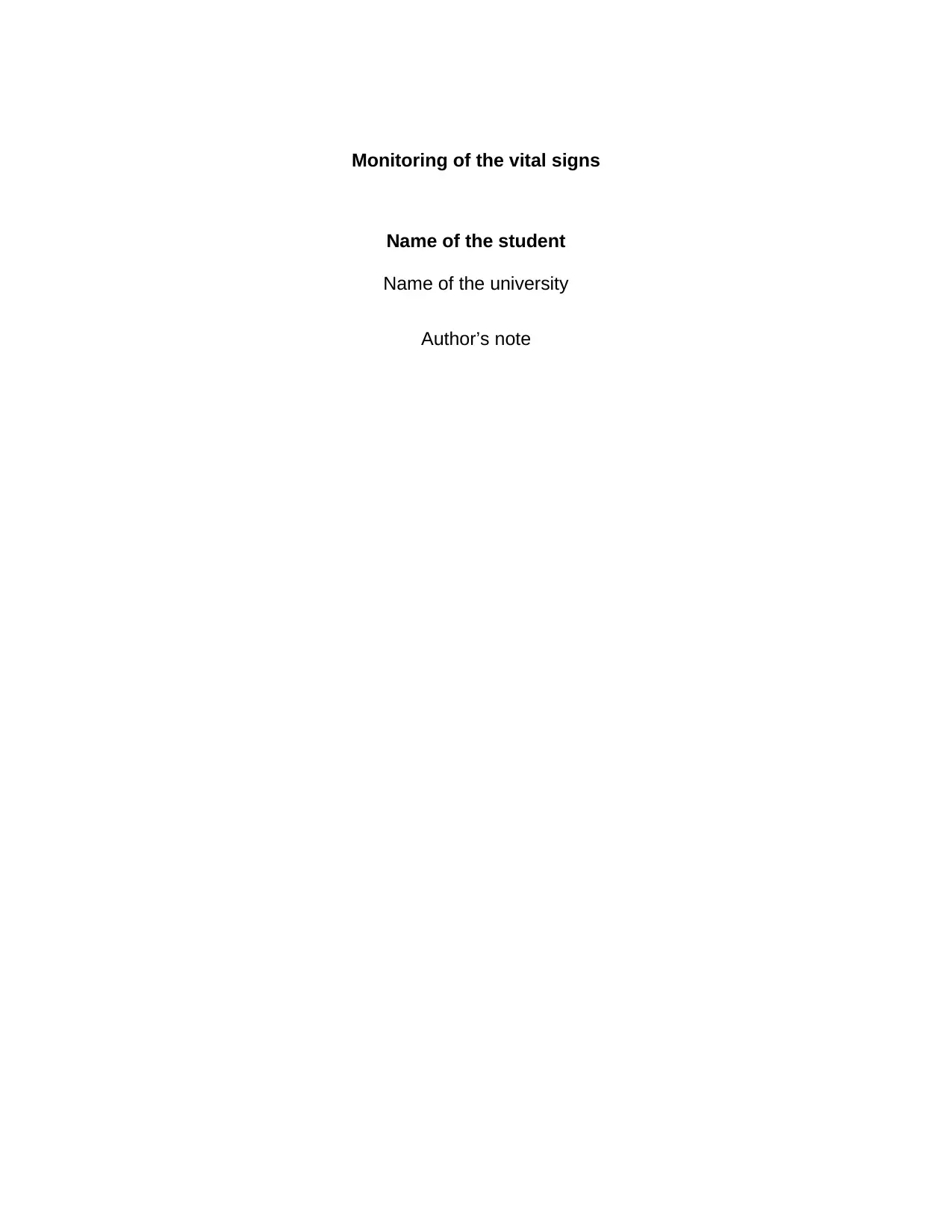
Monitoring of the vital signs
Name of the student
Name of the university
Author’s note
Name of the student
Name of the university
Author’s note
Paraphrase This Document
Need a fresh take? Get an instant paraphrase of this document with our AI Paraphraser

CHAPTER 2: REVIEW OF LITERATURE
2.1 Introduction
In this chapter, an overview of previous research on CCRT, Modified early
warning score, clinical deterioration will be discussed .It introduces the framework for
the studies that comprises the main focus of the research described in this study. The
literature search methodology will be explained and discussed. The publications year of
all the articles will be adjusted accordingly to ensure enough data is collected to analyze
this topic. Research articles on the advantages and limitations will be explored to get
more information. The most relevant and up to date articles will be reviewed.
2.2 Data Extraction Strategy
The search was initiated through The National Centre for Biotechnology
Information (NCBI) using PubMed, Medscape, Science Direct, Cochrane and Research
Gate, Google Scholar search, CINAHL Nursing Journal Databases and Springer. This
chapter will explain how important of early identification of deteriorating patients with
proper treatment according to patient condition that may help patient in their survival.
The key words that used to search article for this study is Modified early warning score
and Rapid Response team which discovered 18,900 articles.
Besides that, searching was done by using specific words which all related to this study
such as clinical deterioration, unplanned admission to Intensive care Unit, code blue
and mortality shows 4,450 articles.
2.1 Introduction
In this chapter, an overview of previous research on CCRT, Modified early
warning score, clinical deterioration will be discussed .It introduces the framework for
the studies that comprises the main focus of the research described in this study. The
literature search methodology will be explained and discussed. The publications year of
all the articles will be adjusted accordingly to ensure enough data is collected to analyze
this topic. Research articles on the advantages and limitations will be explored to get
more information. The most relevant and up to date articles will be reviewed.
2.2 Data Extraction Strategy
The search was initiated through The National Centre for Biotechnology
Information (NCBI) using PubMed, Medscape, Science Direct, Cochrane and Research
Gate, Google Scholar search, CINAHL Nursing Journal Databases and Springer. This
chapter will explain how important of early identification of deteriorating patients with
proper treatment according to patient condition that may help patient in their survival.
The key words that used to search article for this study is Modified early warning score
and Rapid Response team which discovered 18,900 articles.
Besides that, searching was done by using specific words which all related to this study
such as clinical deterioration, unplanned admission to Intensive care Unit, code blue
and mortality shows 4,450 articles.
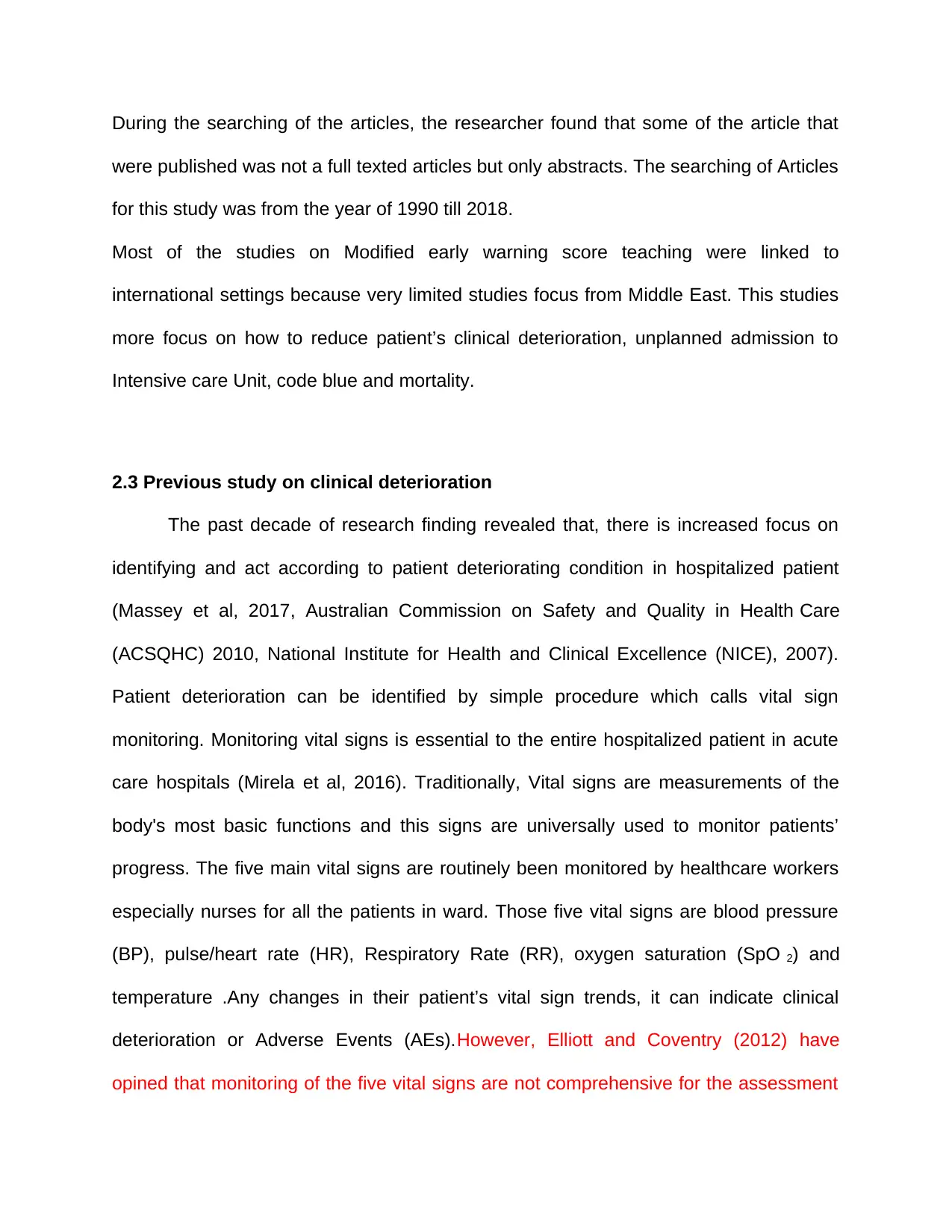
During the searching of the articles, the researcher found that some of the article that
were published was not a full texted articles but only abstracts. The searching of Articles
for this study was from the year of 1990 till 2018.
Most of the studies on Modified early warning score teaching were linked to
international settings because very limited studies focus from Middle East. This studies
more focus on how to reduce patient’s clinical deterioration, unplanned admission to
Intensive care Unit, code blue and mortality.
2.3 Previous study on clinical deterioration
The past decade of research finding revealed that, there is increased focus on
identifying and act according to patient deteriorating condition in hospitalized patient
(Massey et al, 2017, Australian Commission on Safety and Quality in Health Care
(ACSQHC) 2010, National Institute for Health and Clinical Excellence (NICE), 2007).
Patient deterioration can be identified by simple procedure which calls vital sign
monitoring. Monitoring vital signs is essential to the entire hospitalized patient in acute
care hospitals (Mirela et al, 2016). Traditionally, Vital signs are measurements of the
body's most basic functions and this signs are universally used to monitor patients’
progress. The five main vital signs are routinely been monitored by healthcare workers
especially nurses for all the patients in ward. Those five vital signs are blood pressure
(BP), pulse/heart rate (HR), Respiratory Rate (RR), oxygen saturation (SpO 2) and
temperature .Any changes in their patient’s vital sign trends, it can indicate clinical
deterioration or Adverse Events (AEs).However, Elliott and Coventry (2012) have
opined that monitoring of the five vital signs are not comprehensive for the assessment
were published was not a full texted articles but only abstracts. The searching of Articles
for this study was from the year of 1990 till 2018.
Most of the studies on Modified early warning score teaching were linked to
international settings because very limited studies focus from Middle East. This studies
more focus on how to reduce patient’s clinical deterioration, unplanned admission to
Intensive care Unit, code blue and mortality.
2.3 Previous study on clinical deterioration
The past decade of research finding revealed that, there is increased focus on
identifying and act according to patient deteriorating condition in hospitalized patient
(Massey et al, 2017, Australian Commission on Safety and Quality in Health Care
(ACSQHC) 2010, National Institute for Health and Clinical Excellence (NICE), 2007).
Patient deterioration can be identified by simple procedure which calls vital sign
monitoring. Monitoring vital signs is essential to the entire hospitalized patient in acute
care hospitals (Mirela et al, 2016). Traditionally, Vital signs are measurements of the
body's most basic functions and this signs are universally used to monitor patients’
progress. The five main vital signs are routinely been monitored by healthcare workers
especially nurses for all the patients in ward. Those five vital signs are blood pressure
(BP), pulse/heart rate (HR), Respiratory Rate (RR), oxygen saturation (SpO 2) and
temperature .Any changes in their patient’s vital sign trends, it can indicate clinical
deterioration or Adverse Events (AEs).However, Elliott and Coventry (2012) have
opined that monitoring of the five vital signs are not comprehensive for the assessment
⊘ This is a preview!⊘
Do you want full access?
Subscribe today to unlock all pages.

Trusted by 1+ million students worldwide
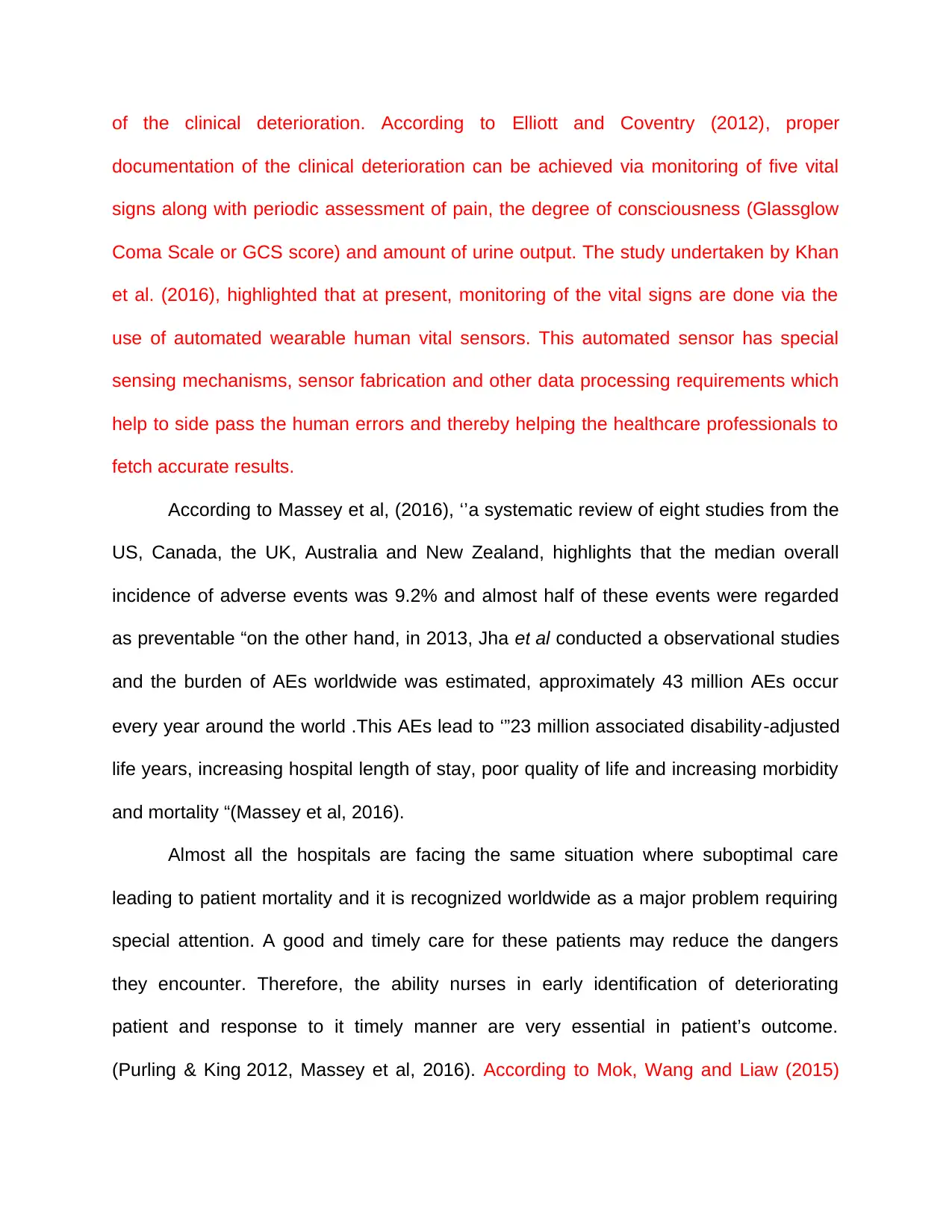
of the clinical deterioration. According to Elliott and Coventry (2012), proper
documentation of the clinical deterioration can be achieved via monitoring of five vital
signs along with periodic assessment of pain, the degree of consciousness (Glassglow
Coma Scale or GCS score) and amount of urine output. The study undertaken by Khan
et al. (2016), highlighted that at present, monitoring of the vital signs are done via the
use of automated wearable human vital sensors. This automated sensor has special
sensing mechanisms, sensor fabrication and other data processing requirements which
help to side pass the human errors and thereby helping the healthcare professionals to
fetch accurate results.
According to Massey et al, (2016), ‘’a systematic review of eight studies from the
US, Canada, the UK, Australia and New Zealand, highlights that the median overall
incidence of adverse events was 9.2% and almost half of these events were regarded
as preventable “on the other hand, in 2013, Jha et al conducted a observational studies
and the burden of AEs worldwide was estimated, approximately 43 million AEs occur
every year around the world .This AEs lead to ‘”23 million associated disability‐adjusted
life years, increasing hospital length of stay, poor quality of life and increasing morbidity
and mortality “(Massey et al, 2016).
Almost all the hospitals are facing the same situation where suboptimal care
leading to patient mortality and it is recognized worldwide as a major problem requiring
special attention. A good and timely care for these patients may reduce the dangers
they encounter. Therefore, the ability nurses in early identification of deteriorating
patient and response to it timely manner are very essential in patient’s outcome.
(Purling & King 2012, Massey et al, 2016). According to Mok, Wang and Liaw (2015)
documentation of the clinical deterioration can be achieved via monitoring of five vital
signs along with periodic assessment of pain, the degree of consciousness (Glassglow
Coma Scale or GCS score) and amount of urine output. The study undertaken by Khan
et al. (2016), highlighted that at present, monitoring of the vital signs are done via the
use of automated wearable human vital sensors. This automated sensor has special
sensing mechanisms, sensor fabrication and other data processing requirements which
help to side pass the human errors and thereby helping the healthcare professionals to
fetch accurate results.
According to Massey et al, (2016), ‘’a systematic review of eight studies from the
US, Canada, the UK, Australia and New Zealand, highlights that the median overall
incidence of adverse events was 9.2% and almost half of these events were regarded
as preventable “on the other hand, in 2013, Jha et al conducted a observational studies
and the burden of AEs worldwide was estimated, approximately 43 million AEs occur
every year around the world .This AEs lead to ‘”23 million associated disability‐adjusted
life years, increasing hospital length of stay, poor quality of life and increasing morbidity
and mortality “(Massey et al, 2016).
Almost all the hospitals are facing the same situation where suboptimal care
leading to patient mortality and it is recognized worldwide as a major problem requiring
special attention. A good and timely care for these patients may reduce the dangers
they encounter. Therefore, the ability nurses in early identification of deteriorating
patient and response to it timely manner are very essential in patient’s outcome.
(Purling & King 2012, Massey et al, 2016). According to Mok, Wang and Liaw (2015)
Paraphrase This Document
Need a fresh take? Get an instant paraphrase of this document with our AI Paraphraser
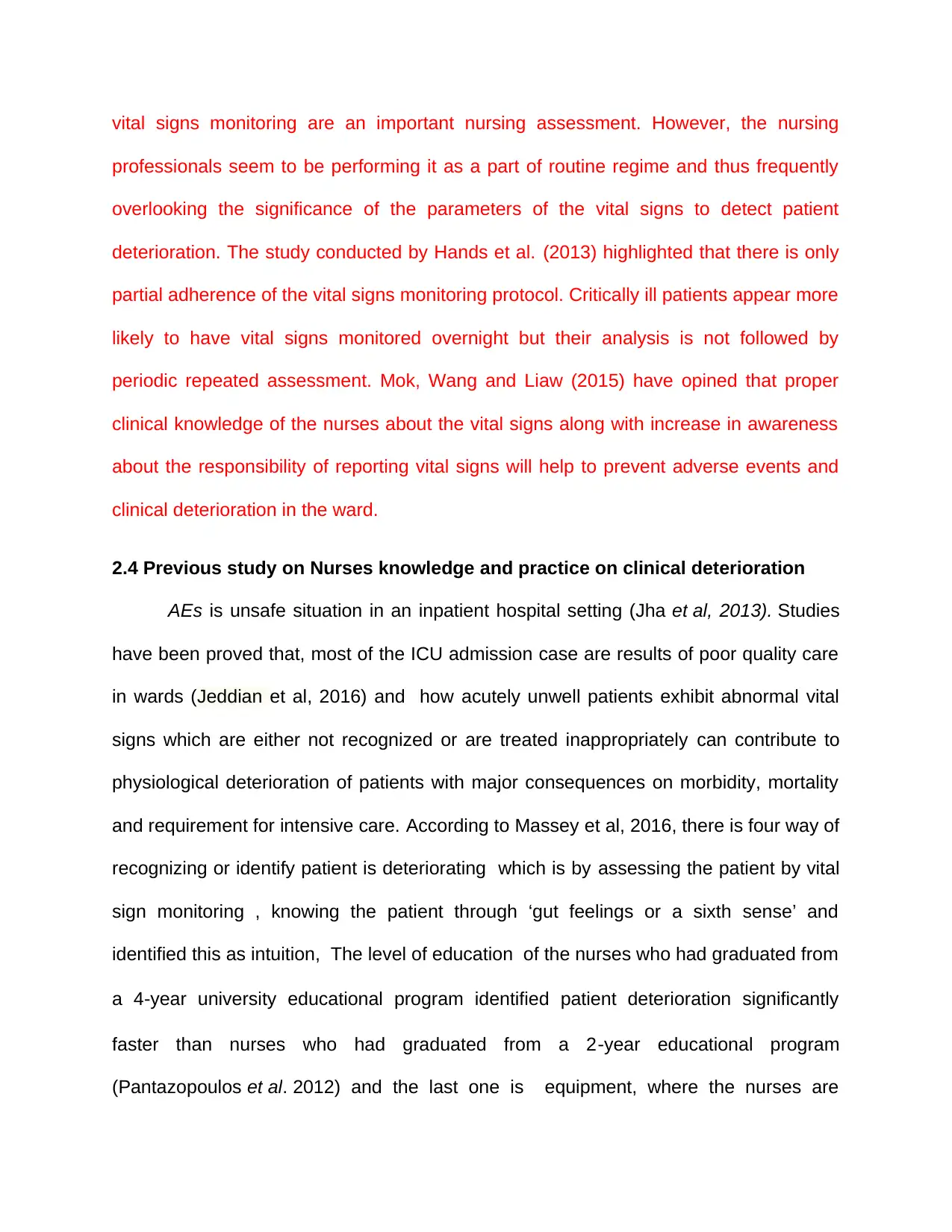
vital signs monitoring are an important nursing assessment. However, the nursing
professionals seem to be performing it as a part of routine regime and thus frequently
overlooking the significance of the parameters of the vital signs to detect patient
deterioration. The study conducted by Hands et al. (2013) highlighted that there is only
partial adherence of the vital signs monitoring protocol. Critically ill patients appear more
likely to have vital signs monitored overnight but their analysis is not followed by
periodic repeated assessment. Mok, Wang and Liaw (2015) have opined that proper
clinical knowledge of the nurses about the vital signs along with increase in awareness
about the responsibility of reporting vital signs will help to prevent adverse events and
clinical deterioration in the ward.
2.4 Previous study on Nurses knowledge and practice on clinical deterioration
AEs is unsafe situation in an inpatient hospital setting (Jha et al, 2013). Studies
have been proved that, most of the ICU admission case are results of poor quality care
in wards (Jeddian et al, 2016) and how acutely unwell patients exhibit abnormal vital
signs which are either not recognized or are treated inappropriately can contribute to
physiological deterioration of patients with major consequences on morbidity, mortality
and requirement for intensive care. According to Massey et al, 2016, there is four way of
recognizing or identify patient is deteriorating which is by assessing the patient by vital
sign monitoring , knowing the patient through ‘gut feelings or a sixth sense’ and
identified this as intuition, The level of education of the nurses who had graduated from
a 4‐year university educational program identified patient deterioration significantly
faster than nurses who had graduated from a 2‐year educational program
(Pantazopoulos et al. 2012) and the last one is equipment, where the nurses are
professionals seem to be performing it as a part of routine regime and thus frequently
overlooking the significance of the parameters of the vital signs to detect patient
deterioration. The study conducted by Hands et al. (2013) highlighted that there is only
partial adherence of the vital signs monitoring protocol. Critically ill patients appear more
likely to have vital signs monitored overnight but their analysis is not followed by
periodic repeated assessment. Mok, Wang and Liaw (2015) have opined that proper
clinical knowledge of the nurses about the vital signs along with increase in awareness
about the responsibility of reporting vital signs will help to prevent adverse events and
clinical deterioration in the ward.
2.4 Previous study on Nurses knowledge and practice on clinical deterioration
AEs is unsafe situation in an inpatient hospital setting (Jha et al, 2013). Studies
have been proved that, most of the ICU admission case are results of poor quality care
in wards (Jeddian et al, 2016) and how acutely unwell patients exhibit abnormal vital
signs which are either not recognized or are treated inappropriately can contribute to
physiological deterioration of patients with major consequences on morbidity, mortality
and requirement for intensive care. According to Massey et al, 2016, there is four way of
recognizing or identify patient is deteriorating which is by assessing the patient by vital
sign monitoring , knowing the patient through ‘gut feelings or a sixth sense’ and
identified this as intuition, The level of education of the nurses who had graduated from
a 4‐year university educational program identified patient deterioration significantly
faster than nurses who had graduated from a 2‐year educational program
(Pantazopoulos et al. 2012) and the last one is equipment, where the nurses are

Unfamiliarity with equipment which cause the nurses fail to patient who are at high risk
of deterioration. In 2016 , Mirela with other researcher conducted a structured surveys
and it shows that ,Nurses were not confident about the accuracy of current equipment
used to measure vital signs and about 52.7% nurses from neurosurgery department
believe that automated observation machine did not give a proper reading. Nurses
knowledge and practice is vital in identify patient who are deteriorating, their Clinical
decision making is fundamental to the daily practice as well but in some condition they
are reluctant to escalate care due to concerns they might be criticized if the patient is
not that unwell and about 23.9% of the nurses agreed that due to time constraints most
of vital sign and the accurate of the vital sign monitoring been neglected (Wenqi Mok
et al. 2015). The study conducted by Yoder et al. (2013) reported that nurses also failed
to understand the urgency of monitoring of the vital signs. Their study highlighted that
overnight vital signs are collected frequently among the patients of the wards
irrespective of their risk of clinical deterioration. Yoder et al. (2013) suggested that
nighttime frequency of vital signs monitoring for the low risk inpatients must be reduced
and such reduction is bound to bring dramatic benefits to the seep of the low risk
patients and thereby reducing their length in the hospital stay. According to Mok et al.
(2015), there is a need for continuous professional development in order to improve the
attitudes of the ward nurses towards vital signs monitoring via prioritizing the workload
planning.
2.5 Previous study on Rapid Response Team (RRT)
As part of IHI’s 100,000 Lives Campaign some 1,500 hospitals are now actively
using and/or implementing RRS. The rate of Cardiac arrest, mortality, and lengths of
of deterioration. In 2016 , Mirela with other researcher conducted a structured surveys
and it shows that ,Nurses were not confident about the accuracy of current equipment
used to measure vital signs and about 52.7% nurses from neurosurgery department
believe that automated observation machine did not give a proper reading. Nurses
knowledge and practice is vital in identify patient who are deteriorating, their Clinical
decision making is fundamental to the daily practice as well but in some condition they
are reluctant to escalate care due to concerns they might be criticized if the patient is
not that unwell and about 23.9% of the nurses agreed that due to time constraints most
of vital sign and the accurate of the vital sign monitoring been neglected (Wenqi Mok
et al. 2015). The study conducted by Yoder et al. (2013) reported that nurses also failed
to understand the urgency of monitoring of the vital signs. Their study highlighted that
overnight vital signs are collected frequently among the patients of the wards
irrespective of their risk of clinical deterioration. Yoder et al. (2013) suggested that
nighttime frequency of vital signs monitoring for the low risk inpatients must be reduced
and such reduction is bound to bring dramatic benefits to the seep of the low risk
patients and thereby reducing their length in the hospital stay. According to Mok et al.
(2015), there is a need for continuous professional development in order to improve the
attitudes of the ward nurses towards vital signs monitoring via prioritizing the workload
planning.
2.5 Previous study on Rapid Response Team (RRT)
As part of IHI’s 100,000 Lives Campaign some 1,500 hospitals are now actively
using and/or implementing RRS. The rate of Cardiac arrest, mortality, and lengths of
⊘ This is a preview!⊘
Do you want full access?
Subscribe today to unlock all pages.

Trusted by 1+ million students worldwide
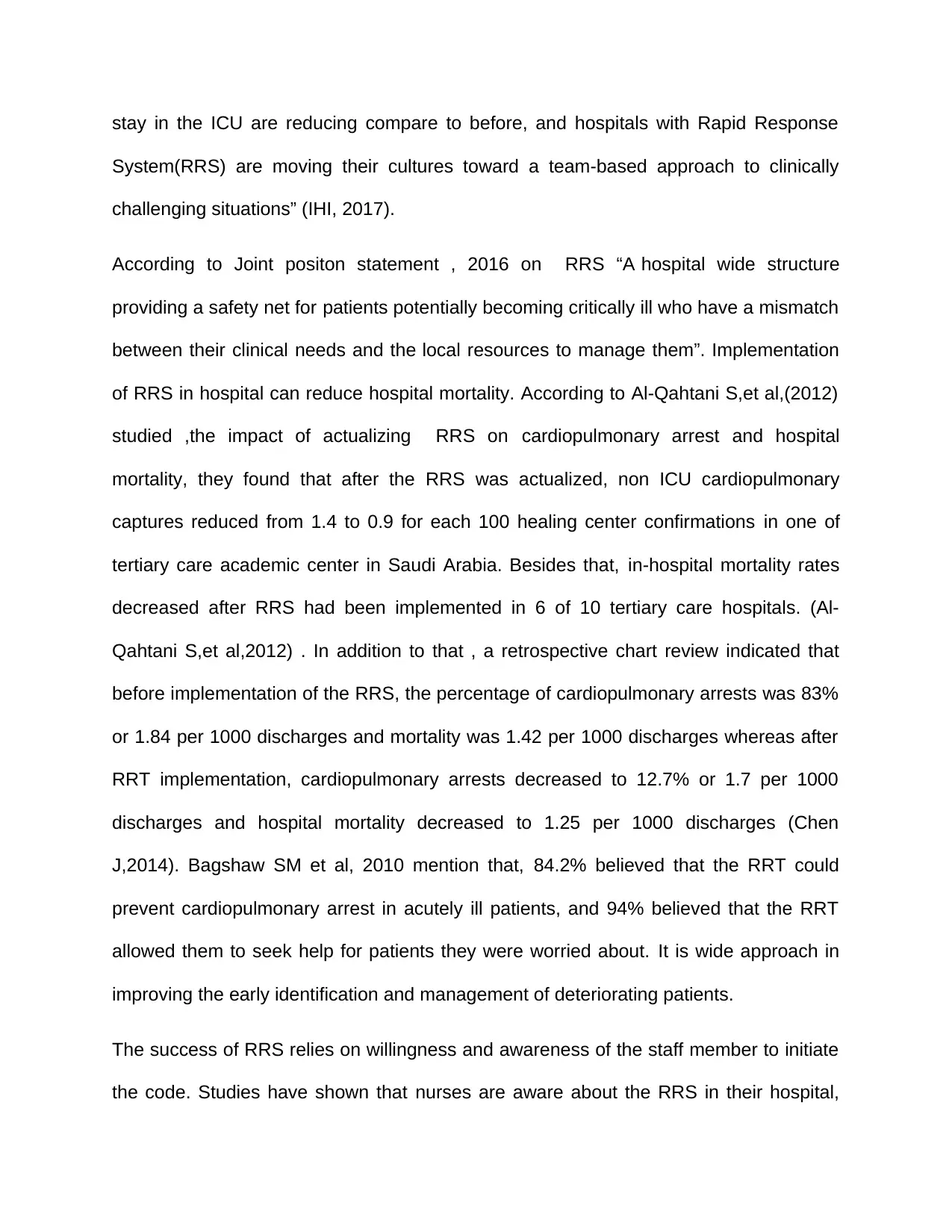
stay in the ICU are reducing compare to before, and hospitals with Rapid Response
System(RRS) are moving their cultures toward a team-based approach to clinically
challenging situations” (IHI, 2017).
According to Joint positon statement , 2016 on RRS “A hospital wide structure
providing a safety net for patients potentially becoming critically ill who have a mismatch
between their clinical needs and the local resources to manage them”. Implementation
of RRS in hospital can reduce hospital mortality. According to Al-Qahtani S,et al,(2012)
studied ,the impact of actualizing RRS on cardiopulmonary arrest and hospital
mortality, they found that after the RRS was actualized, non ICU cardiopulmonary
captures reduced from 1.4 to 0.9 for each 100 healing center confirmations in one of
tertiary care academic center in Saudi Arabia. Besides that, in-hospital mortality rates
decreased after RRS had been implemented in 6 of 10 tertiary care hospitals. (Al-
Qahtani S,et al,2012) . In addition to that , a retrospective chart review indicated that
before implementation of the RRS, the percentage of cardiopulmonary arrests was 83%
or 1.84 per 1000 discharges and mortality was 1.42 per 1000 discharges whereas after
RRT implementation, cardiopulmonary arrests decreased to 12.7% or 1.7 per 1000
discharges and hospital mortality decreased to 1.25 per 1000 discharges (Chen
J,2014). Bagshaw SM et al, 2010 mention that, 84.2% believed that the RRT could
prevent cardiopulmonary arrest in acutely ill patients, and 94% believed that the RRT
allowed them to seek help for patients they were worried about. It is wide approach in
improving the early identification and management of deteriorating patients.
The success of RRS relies on willingness and awareness of the staff member to initiate
the code. Studies have shown that nurses are aware about the RRS in their hospital,
System(RRS) are moving their cultures toward a team-based approach to clinically
challenging situations” (IHI, 2017).
According to Joint positon statement , 2016 on RRS “A hospital wide structure
providing a safety net for patients potentially becoming critically ill who have a mismatch
between their clinical needs and the local resources to manage them”. Implementation
of RRS in hospital can reduce hospital mortality. According to Al-Qahtani S,et al,(2012)
studied ,the impact of actualizing RRS on cardiopulmonary arrest and hospital
mortality, they found that after the RRS was actualized, non ICU cardiopulmonary
captures reduced from 1.4 to 0.9 for each 100 healing center confirmations in one of
tertiary care academic center in Saudi Arabia. Besides that, in-hospital mortality rates
decreased after RRS had been implemented in 6 of 10 tertiary care hospitals. (Al-
Qahtani S,et al,2012) . In addition to that , a retrospective chart review indicated that
before implementation of the RRS, the percentage of cardiopulmonary arrests was 83%
or 1.84 per 1000 discharges and mortality was 1.42 per 1000 discharges whereas after
RRT implementation, cardiopulmonary arrests decreased to 12.7% or 1.7 per 1000
discharges and hospital mortality decreased to 1.25 per 1000 discharges (Chen
J,2014). Bagshaw SM et al, 2010 mention that, 84.2% believed that the RRT could
prevent cardiopulmonary arrest in acutely ill patients, and 94% believed that the RRT
allowed them to seek help for patients they were worried about. It is wide approach in
improving the early identification and management of deteriorating patients.
The success of RRS relies on willingness and awareness of the staff member to initiate
the code. Studies have shown that nurses are aware about the RRS in their hospital,
Paraphrase This Document
Need a fresh take? Get an instant paraphrase of this document with our AI Paraphraser

yet many still hesitate to activate it when patient is showing sign and symptom of
deterioration; Fifteen percent indicated reluctance to activate the RRS because of fear
of criticism, but only 2.2% considered the RRT overused. (Sean M,et al,2010)
Studies revealed that the relationship between nurses and physicians can be a
barrier, because many nurses believe that the physician should be contacted before an
RRS (Leach LS, 2013). Most nurses (75.9%) would call the responsible physician
before activating the RRS (Bagshaw SM et al, 2010). Hence, the RRS alone is in
essence more reactive than preventive in nature.
2.6 Previous study on Modified early warning Score (MEWS)
In 1997, Morgan, Williams, and Wright introduced the Early Warning System
(EWS). The EWS is one of the parts of the RRS. The EWS help to identify the patient
who are at the risk level for the clinical deterioration. The EWS is trigger, which is known
as the Medical Emergency team. This was begun in 2004. The result of the rapid
response of the team evolution starts the effectiveness of EWS in the education system
(Williams et al. 2012).
EWS helps to measure different physiological parameters of the patient’s vital signs
which is heart rate, respiratory rate, systolic blood pressure, temperature, and
consciousness level (Kyriacos, Jelsma and Jordan 2011). EWS help in predict
outcomes and also to serve as a track and trigger system to recognize early signs of
deterioration (Mathukia et al, 2015). In the United Kingdom, EWS was modified to
Modified Early Warning System (MEWS) (Mathukia et al, 2015).The National Institute
for Health and Clinical Excellence (NICE), (2007) recommended that MEWS should
deterioration; Fifteen percent indicated reluctance to activate the RRS because of fear
of criticism, but only 2.2% considered the RRT overused. (Sean M,et al,2010)
Studies revealed that the relationship between nurses and physicians can be a
barrier, because many nurses believe that the physician should be contacted before an
RRS (Leach LS, 2013). Most nurses (75.9%) would call the responsible physician
before activating the RRS (Bagshaw SM et al, 2010). Hence, the RRS alone is in
essence more reactive than preventive in nature.
2.6 Previous study on Modified early warning Score (MEWS)
In 1997, Morgan, Williams, and Wright introduced the Early Warning System
(EWS). The EWS is one of the parts of the RRS. The EWS help to identify the patient
who are at the risk level for the clinical deterioration. The EWS is trigger, which is known
as the Medical Emergency team. This was begun in 2004. The result of the rapid
response of the team evolution starts the effectiveness of EWS in the education system
(Williams et al. 2012).
EWS helps to measure different physiological parameters of the patient’s vital signs
which is heart rate, respiratory rate, systolic blood pressure, temperature, and
consciousness level (Kyriacos, Jelsma and Jordan 2011). EWS help in predict
outcomes and also to serve as a track and trigger system to recognize early signs of
deterioration (Mathukia et al, 2015). In the United Kingdom, EWS was modified to
Modified Early Warning System (MEWS) (Mathukia et al, 2015).The National Institute
for Health and Clinical Excellence (NICE), (2007) recommended that MEWS should
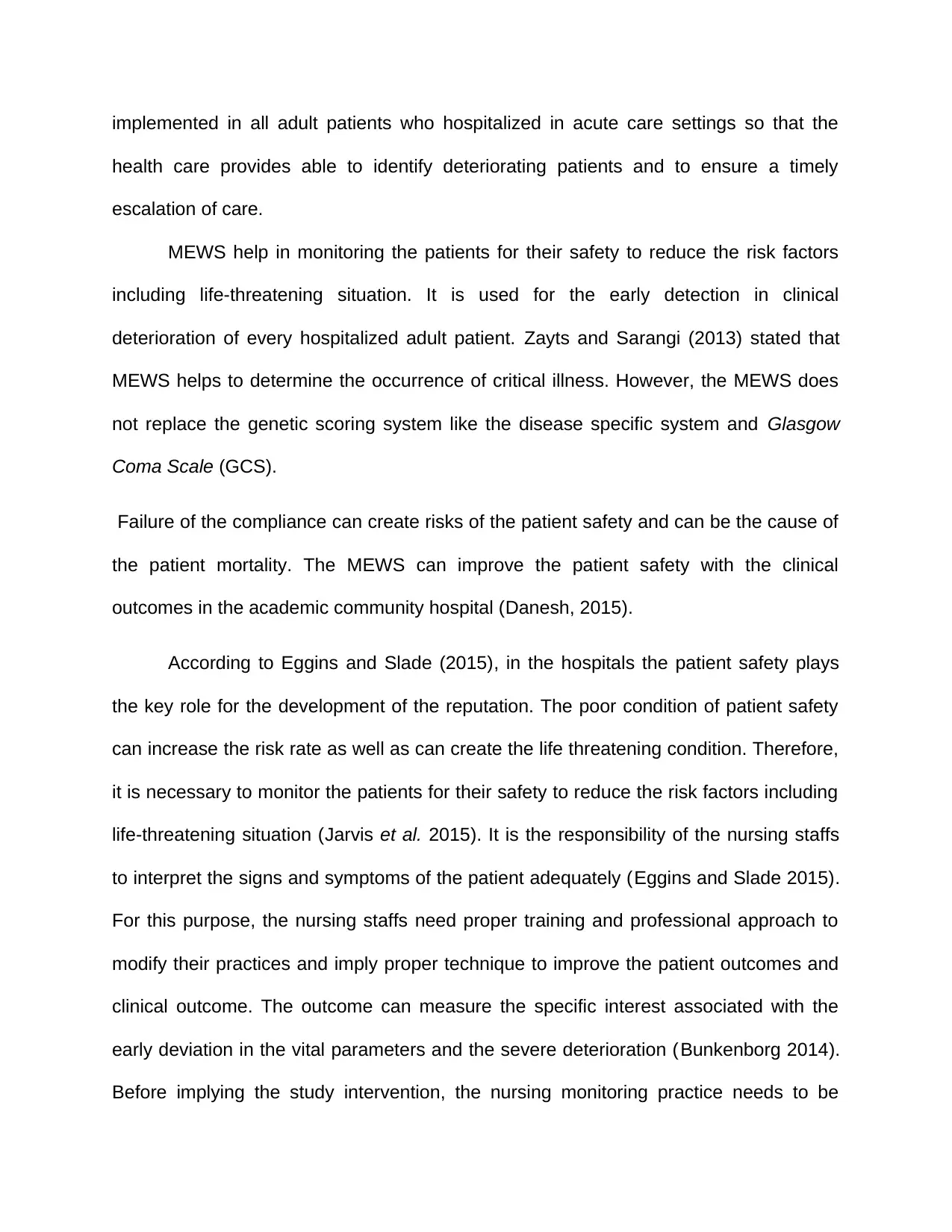
implemented in all adult patients who hospitalized in acute care settings so that the
health care provides able to identify deteriorating patients and to ensure a timely
escalation of care.
MEWS help in monitoring the patients for their safety to reduce the risk factors
including life-threatening situation. It is used for the early detection in clinical
deterioration of every hospitalized adult patient. Zayts and Sarangi (2013) stated that
MEWS helps to determine the occurrence of critical illness. However, the MEWS does
not replace the genetic scoring system like the disease specific system and Glasgow
Coma Scale (GCS).
Failure of the compliance can create risks of the patient safety and can be the cause of
the patient mortality. The MEWS can improve the patient safety with the clinical
outcomes in the academic community hospital (Danesh, 2015).
According to Eggins and Slade (2015), in the hospitals the patient safety plays
the key role for the development of the reputation. The poor condition of patient safety
can increase the risk rate as well as can create the life threatening condition. Therefore,
it is necessary to monitor the patients for their safety to reduce the risk factors including
life-threatening situation (Jarvis et al. 2015). It is the responsibility of the nursing staffs
to interpret the signs and symptoms of the patient adequately (Eggins and Slade 2015).
For this purpose, the nursing staffs need proper training and professional approach to
modify their practices and imply proper technique to improve the patient outcomes and
clinical outcome. The outcome can measure the specific interest associated with the
early deviation in the vital parameters and the severe deterioration (Bunkenborg 2014).
Before implying the study intervention, the nursing monitoring practice needs to be
health care provides able to identify deteriorating patients and to ensure a timely
escalation of care.
MEWS help in monitoring the patients for their safety to reduce the risk factors
including life-threatening situation. It is used for the early detection in clinical
deterioration of every hospitalized adult patient. Zayts and Sarangi (2013) stated that
MEWS helps to determine the occurrence of critical illness. However, the MEWS does
not replace the genetic scoring system like the disease specific system and Glasgow
Coma Scale (GCS).
Failure of the compliance can create risks of the patient safety and can be the cause of
the patient mortality. The MEWS can improve the patient safety with the clinical
outcomes in the academic community hospital (Danesh, 2015).
According to Eggins and Slade (2015), in the hospitals the patient safety plays
the key role for the development of the reputation. The poor condition of patient safety
can increase the risk rate as well as can create the life threatening condition. Therefore,
it is necessary to monitor the patients for their safety to reduce the risk factors including
life-threatening situation (Jarvis et al. 2015). It is the responsibility of the nursing staffs
to interpret the signs and symptoms of the patient adequately (Eggins and Slade 2015).
For this purpose, the nursing staffs need proper training and professional approach to
modify their practices and imply proper technique to improve the patient outcomes and
clinical outcome. The outcome can measure the specific interest associated with the
early deviation in the vital parameters and the severe deterioration (Bunkenborg 2014).
Before implying the study intervention, the nursing monitoring practice needs to be
⊘ This is a preview!⊘
Do you want full access?
Subscribe today to unlock all pages.

Trusted by 1+ million students worldwide
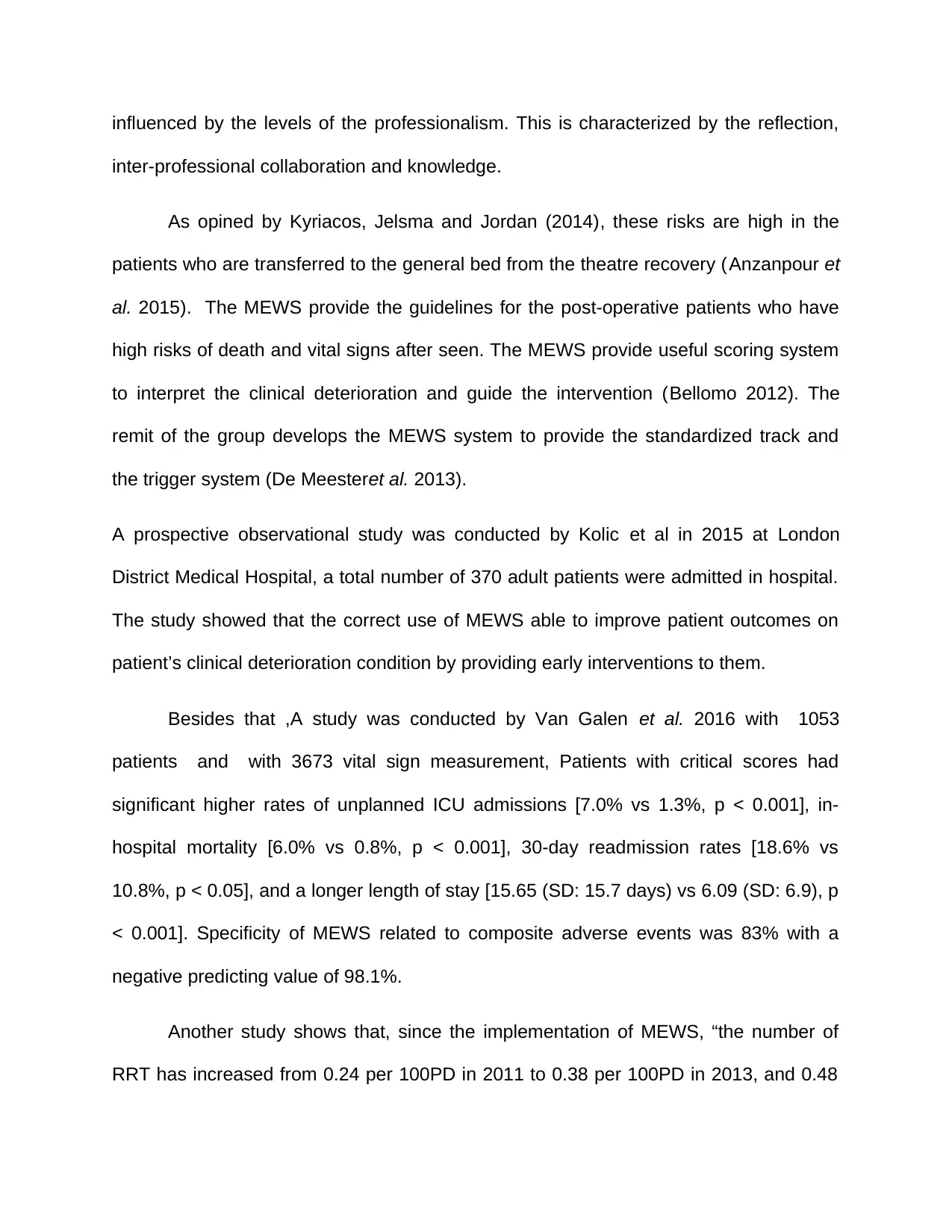
influenced by the levels of the professionalism. This is characterized by the reflection,
inter-professional collaboration and knowledge.
As opined by Kyriacos, Jelsma and Jordan (2014), these risks are high in the
patients who are transferred to the general bed from the theatre recovery (Anzanpour et
al. 2015). The MEWS provide the guidelines for the post-operative patients who have
high risks of death and vital signs after seen. The MEWS provide useful scoring system
to interpret the clinical deterioration and guide the intervention (Bellomo 2012). The
remit of the group develops the MEWS system to provide the standardized track and
the trigger system (De Meesteret al. 2013).
A prospective observational study was conducted by Kolic et al in 2015 at London
District Medical Hospital, a total number of 370 adult patients were admitted in hospital.
The study showed that the correct use of MEWS able to improve patient outcomes on
patient’s clinical deterioration condition by providing early interventions to them.
Besides that ,A study was conducted by Van Galen et al. 2016 with 1053
patients and with 3673 vital sign measurement, Patients with critical scores had
significant higher rates of unplanned ICU admissions [7.0% vs 1.3%, p < 0.001], in-
hospital mortality [6.0% vs 0.8%, p < 0.001], 30-day readmission rates [18.6% vs
10.8%, p < 0.05], and a longer length of stay [15.65 (SD: 15.7 days) vs 6.09 (SD: 6.9), p
< 0.001]. Specificity of MEWS related to composite adverse events was 83% with a
negative predicting value of 98.1%.
Another study shows that, since the implementation of MEWS, “the number of
RRT has increased from 0.24 per 100PD in 2011 to 0.38 per 100PD in 2013, and 0.48
inter-professional collaboration and knowledge.
As opined by Kyriacos, Jelsma and Jordan (2014), these risks are high in the
patients who are transferred to the general bed from the theatre recovery (Anzanpour et
al. 2015). The MEWS provide the guidelines for the post-operative patients who have
high risks of death and vital signs after seen. The MEWS provide useful scoring system
to interpret the clinical deterioration and guide the intervention (Bellomo 2012). The
remit of the group develops the MEWS system to provide the standardized track and
the trigger system (De Meesteret al. 2013).
A prospective observational study was conducted by Kolic et al in 2015 at London
District Medical Hospital, a total number of 370 adult patients were admitted in hospital.
The study showed that the correct use of MEWS able to improve patient outcomes on
patient’s clinical deterioration condition by providing early interventions to them.
Besides that ,A study was conducted by Van Galen et al. 2016 with 1053
patients and with 3673 vital sign measurement, Patients with critical scores had
significant higher rates of unplanned ICU admissions [7.0% vs 1.3%, p < 0.001], in-
hospital mortality [6.0% vs 0.8%, p < 0.001], 30-day readmission rates [18.6% vs
10.8%, p < 0.05], and a longer length of stay [15.65 (SD: 15.7 days) vs 6.09 (SD: 6.9), p
< 0.001]. Specificity of MEWS related to composite adverse events was 83% with a
negative predicting value of 98.1%.
Another study shows that, since the implementation of MEWS, “the number of
RRT has increased from 0.24 per 100PD in 2011 to 0.38 per 100PD in 2013, and 0.48
Paraphrase This Document
Need a fresh take? Get an instant paraphrase of this document with our AI Paraphraser

per 100PD in 2014. The percentage of RRTs that progressed to Code Blue, an indicator
of poor outcome of RRT, has been decreasing. In contrast, the numbers of Code Blue in
non-ICU floors has been progressively decreasing from 0.05 per 100PD in 2011 to 0.02
per 100PD in 2013 and 2014. These improved clinical outcomes are associated with a
decline of overall inpatient mortality rate from 2.3% in 2011 to 1.5% in 2013 and 1.2% in
2014”. (Mathukia et al. 2015).
Naeem and Montenegro (2005) said that that MEWS score introduction helped in
the increase of patients with the rhythm as VF/VT, 8.5% vs. 23.7%. Introduction of
MEWS resulted in a better survival to hospital discharge and it was statistically
significant (5.2% vs. 16.8%). Introduction of MEWS helped in reducing the percentage
of in-hospital cardiac arrest by 16% and death had reduced by 11.6%. Early introduction
of MEWS might decrease the occurrence of cardiac arrests, mortality and will increase
the survival of patients who are admitted in the HDUs, wards and ICUs. Early detection
of the physiological deterioration and the imminent cardiac arrest can allow the help to
arrive early or on time which may indirectly prevent the event of cardiac arrest.
2.7 Previous study on unplanned admission to intensive care unit
The study conducted by Liu et al. (2012), highlighted that early unplanned ICU
transfers occurring within 8 hours of hospitalization are often associated with increased
rate of mortality. Their study revealed that 5% of patients admitted through emergency
department experienced unplanned ICU transfer and this incidence rate are higher
within first 24hours of hospital admission. The main reason highlighted by Liu et al.
(2012) is improper monitoring of the vital signs. The research conducted by Mapp,
Davis and Krowchuk (2013) stated that patients exhibit physiological changes up to 8
of poor outcome of RRT, has been decreasing. In contrast, the numbers of Code Blue in
non-ICU floors has been progressively decreasing from 0.05 per 100PD in 2011 to 0.02
per 100PD in 2013 and 2014. These improved clinical outcomes are associated with a
decline of overall inpatient mortality rate from 2.3% in 2011 to 1.5% in 2013 and 1.2% in
2014”. (Mathukia et al. 2015).
Naeem and Montenegro (2005) said that that MEWS score introduction helped in
the increase of patients with the rhythm as VF/VT, 8.5% vs. 23.7%. Introduction of
MEWS resulted in a better survival to hospital discharge and it was statistically
significant (5.2% vs. 16.8%). Introduction of MEWS helped in reducing the percentage
of in-hospital cardiac arrest by 16% and death had reduced by 11.6%. Early introduction
of MEWS might decrease the occurrence of cardiac arrests, mortality and will increase
the survival of patients who are admitted in the HDUs, wards and ICUs. Early detection
of the physiological deterioration and the imminent cardiac arrest can allow the help to
arrive early or on time which may indirectly prevent the event of cardiac arrest.
2.7 Previous study on unplanned admission to intensive care unit
The study conducted by Liu et al. (2012), highlighted that early unplanned ICU
transfers occurring within 8 hours of hospitalization are often associated with increased
rate of mortality. Their study revealed that 5% of patients admitted through emergency
department experienced unplanned ICU transfer and this incidence rate are higher
within first 24hours of hospital admission. The main reason highlighted by Liu et al.
(2012) is improper monitoring of the vital signs. The research conducted by Mapp,
Davis and Krowchuk (2013) stated that patients exhibit physiological changes up to 8
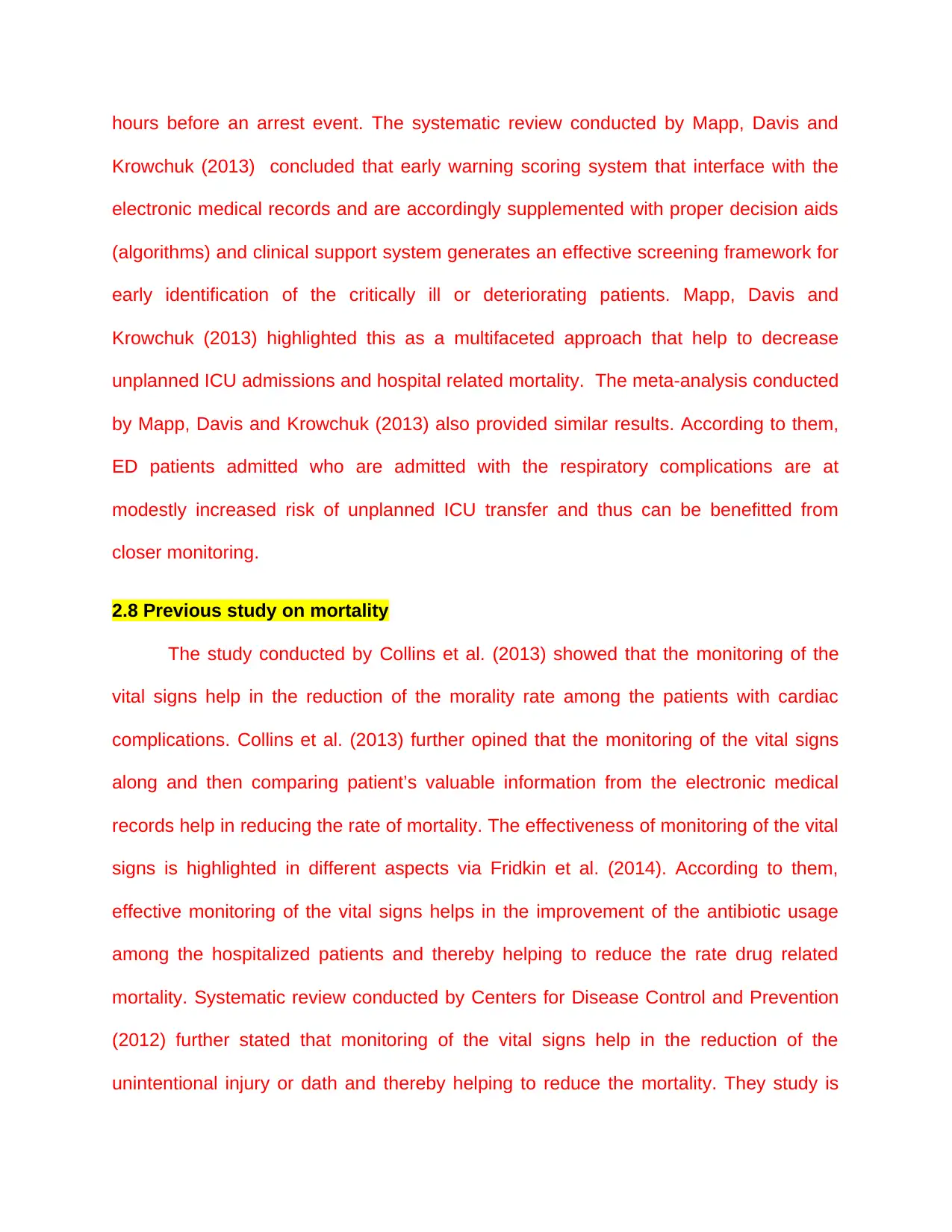
hours before an arrest event. The systematic review conducted by Mapp, Davis and
Krowchuk (2013) concluded that early warning scoring system that interface with the
electronic medical records and are accordingly supplemented with proper decision aids
(algorithms) and clinical support system generates an effective screening framework for
early identification of the critically ill or deteriorating patients. Mapp, Davis and
Krowchuk (2013) highlighted this as a multifaceted approach that help to decrease
unplanned ICU admissions and hospital related mortality. The meta-analysis conducted
by Mapp, Davis and Krowchuk (2013) also provided similar results. According to them,
ED patients admitted who are admitted with the respiratory complications are at
modestly increased risk of unplanned ICU transfer and thus can be benefitted from
closer monitoring.
2.8 Previous study on mortality
The study conducted by Collins et al. (2013) showed that the monitoring of the
vital signs help in the reduction of the morality rate among the patients with cardiac
complications. Collins et al. (2013) further opined that the monitoring of the vital signs
along and then comparing patient’s valuable information from the electronic medical
records help in reducing the rate of mortality. The effectiveness of monitoring of the vital
signs is highlighted in different aspects via Fridkin et al. (2014). According to them,
effective monitoring of the vital signs helps in the improvement of the antibiotic usage
among the hospitalized patients and thereby helping to reduce the rate drug related
mortality. Systematic review conducted by Centers for Disease Control and Prevention
(2012) further stated that monitoring of the vital signs help in the reduction of the
unintentional injury or dath and thereby helping to reduce the mortality. They study is
Krowchuk (2013) concluded that early warning scoring system that interface with the
electronic medical records and are accordingly supplemented with proper decision aids
(algorithms) and clinical support system generates an effective screening framework for
early identification of the critically ill or deteriorating patients. Mapp, Davis and
Krowchuk (2013) highlighted this as a multifaceted approach that help to decrease
unplanned ICU admissions and hospital related mortality. The meta-analysis conducted
by Mapp, Davis and Krowchuk (2013) also provided similar results. According to them,
ED patients admitted who are admitted with the respiratory complications are at
modestly increased risk of unplanned ICU transfer and thus can be benefitted from
closer monitoring.
2.8 Previous study on mortality
The study conducted by Collins et al. (2013) showed that the monitoring of the
vital signs help in the reduction of the morality rate among the patients with cardiac
complications. Collins et al. (2013) further opined that the monitoring of the vital signs
along and then comparing patient’s valuable information from the electronic medical
records help in reducing the rate of mortality. The effectiveness of monitoring of the vital
signs is highlighted in different aspects via Fridkin et al. (2014). According to them,
effective monitoring of the vital signs helps in the improvement of the antibiotic usage
among the hospitalized patients and thereby helping to reduce the rate drug related
mortality. Systematic review conducted by Centers for Disease Control and Prevention
(2012) further stated that monitoring of the vital signs help in the reduction of the
unintentional injury or dath and thereby helping to reduce the mortality. They study is
⊘ This is a preview!⊘
Do you want full access?
Subscribe today to unlock all pages.

Trusted by 1+ million students worldwide
1 out of 27
Related Documents
Your All-in-One AI-Powered Toolkit for Academic Success.
+13062052269
info@desklib.com
Available 24*7 on WhatsApp / Email
![[object Object]](/_next/static/media/star-bottom.7253800d.svg)
Unlock your academic potential
Copyright © 2020–2025 A2Z Services. All Rights Reserved. Developed and managed by ZUCOL.





